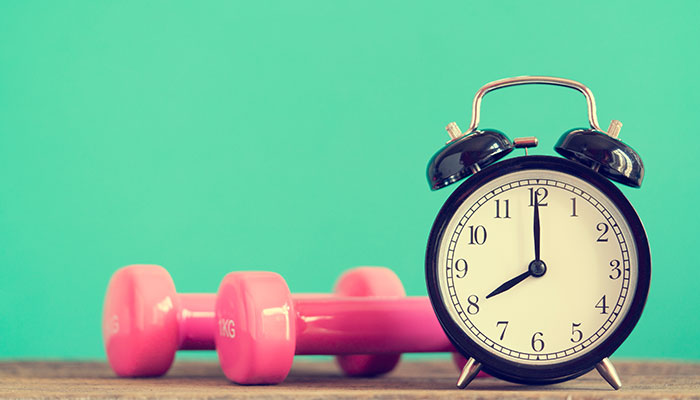Both the national and international recommendations for physical activity and exercise echo each other, and that’s 150 minutes of moderate physical activity spread across most days of the week, or 75 minutes of vigorous activity. In addition to that, you should have two strengthening sessions a week.
If you're exercising too much or too little, there can be serious health consequences, warns Dr Kathryn Mills. Video journalist: Sophie Gidley.
When we looked at the research for our academic review of the benefits versus the negatives of participation in sport and exercise, we found a U-shaped curve response, in that too little exercise will not give you any benefits, and too much exercise will send you back down the U curve, so it can start to be detrimental.
What the exact top of the U is, where you’re getting the right amount of exercise, is going to vary for everyone and depend on many things, including cultural background, what you’ve typically done, as well as the environment you are exercising in, but broadly speaking, all of the data we have says yes, there is a sweet spot, and if you follow the recommendations, they are probably going to put you around that sweet spot.
Similar problems at both extremes
If you’re not doing any exercise, you are not getting injured as a result of participating, but you can become susceptible to many health problems, including weakening bones, heart and circulation problems and metabolic diseases such as diabetes.
Relative Energy Deficiency in Sport (RED-S) is a very dangerous consequence of exercising too much
But very serious health consequences can occur from being both too active and not active enough. An example of this is a heart attack. There is evidence to indicate that a lack of physical activity is a modifiable risk factor for cardiovascular disease. Similarly, competing in endurance events, can expose some people (who have a genetic predisposition to heart problems) to increased risk of dying from a heart attack.
Our research looked at multiple systems, and what we found with the musculoskeletal system is that if you exercise too much, you can start decreasing your bone density because you will run out of energy. We have three major fuel sources - sugars, fats and muscle – and once you exhaust the sugars and fats you are going to start using muscle, and muscle protects bone.

Road to recovery: Rest days are important to ensure you don't overtrain, as excessive exercise can lead to serious health problems.
One of the big reasons why our bone density can reduce with exercise is that we have metabolic and hormonal imbalances. This is particularly common in women – although it is increasingly recognised in men. A lack of oestrogen (and potentially testosterone, but more research needs to be done here) and growth factor is associated with bones being stripped of their calcium content and becoming weaker.
Relative Energy Deficiency in Sport (RED-S) is a very dangerous consequence of exercising too much. We need calcium to be able to contract muscle. When there is none available from our diet, our bones will be stripped of theirs. Muscle mass will also reduce because it is not working properly. This also reduces the support and stresses placed on bone that contributes to their increase in strength.
Motion is lotion, at any age
There is no evidence to support or refute the idea that the older you are, the greater the risks from exercise. Exercise throughout the life span is very important, and that includes during pregnancy.
Many pregnant women are not physically active; often they’re too scared to be. People who are older and have lower bone diseases such as osteoarthritis and osteoporosis are again often too scared, and often that’s because they’ve been told their joints are subject to wear and tear, but we know that that’s not true – motion is lotion! Exercise is medicine! Our joints are designed to move across our lifespans.
Australian Bureau of Statistics data shows that older people and teenagers are equally inactive - our biggest inactive age group in Australia is teenage boys, and data has come out of Ausplay which shows that gross motor skill and fitness levels of our teenagers are definitely lower than in the 1990s.

Keep it moving: Older people and teenage boys are the two most inactive age groups in Australia, according to the Australian Bureau of Statistics.
During our middle ages, we do seem to be doing ok on the physical activity but could be doing more.
Assessing whether someone is exercising too much is specific to individuals: if someone is at a point where they are in relative energy deficit – not eating enough, losing a lot of weight that’s potentially muscle – as well as becoming psychologically dependent on the exercise, you could make an assessment about whether or not it was healthy for them.
But the percentage of the population who overexercise is quite small – within Australia, about 60 to 75 per cent of people are even achieving guidelines – so we are talking about extreme amounts of exercise when we are talking about too much.
The last thing you want to do is say ‘don’t exercise’, because absolutely, go out and exercise and be active, and remember you don’t have to be competitive, you just have to participate – and follow those national recommendations of 150 minutes of moderate activity, and two resistance sessions, every week.
Dr Kathryn Mills is a Physiotherapy Lecturer from the Department of Health Professions.



